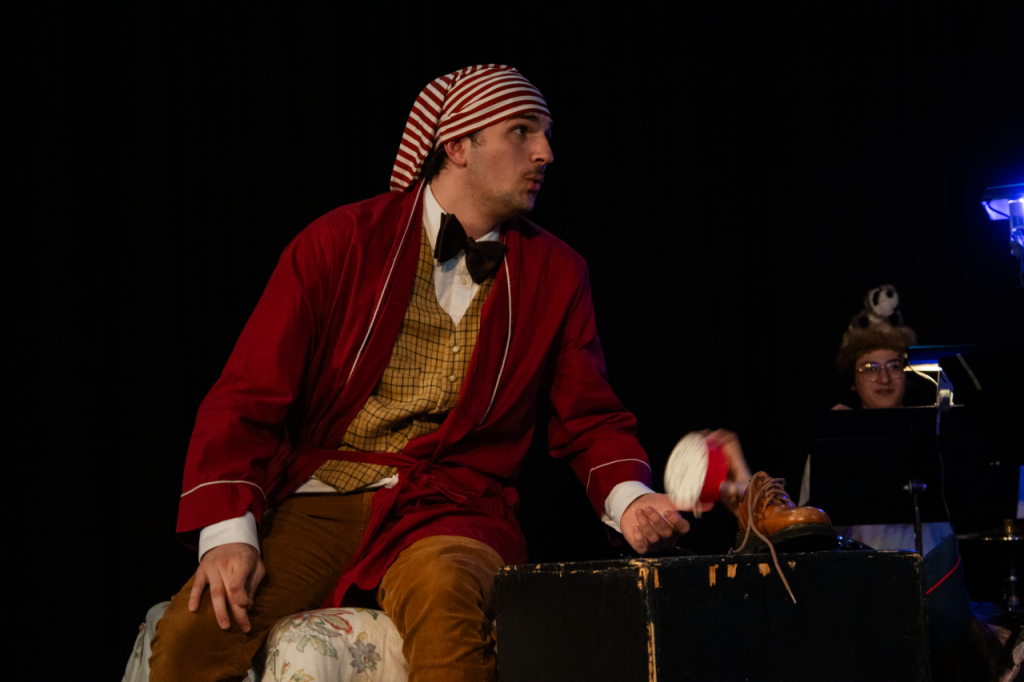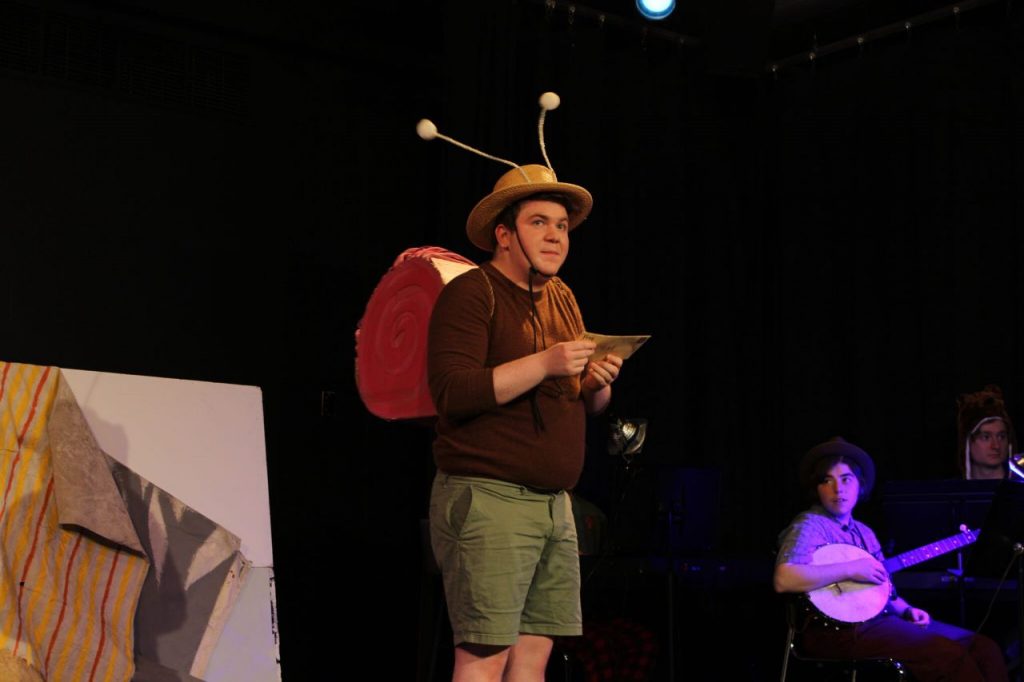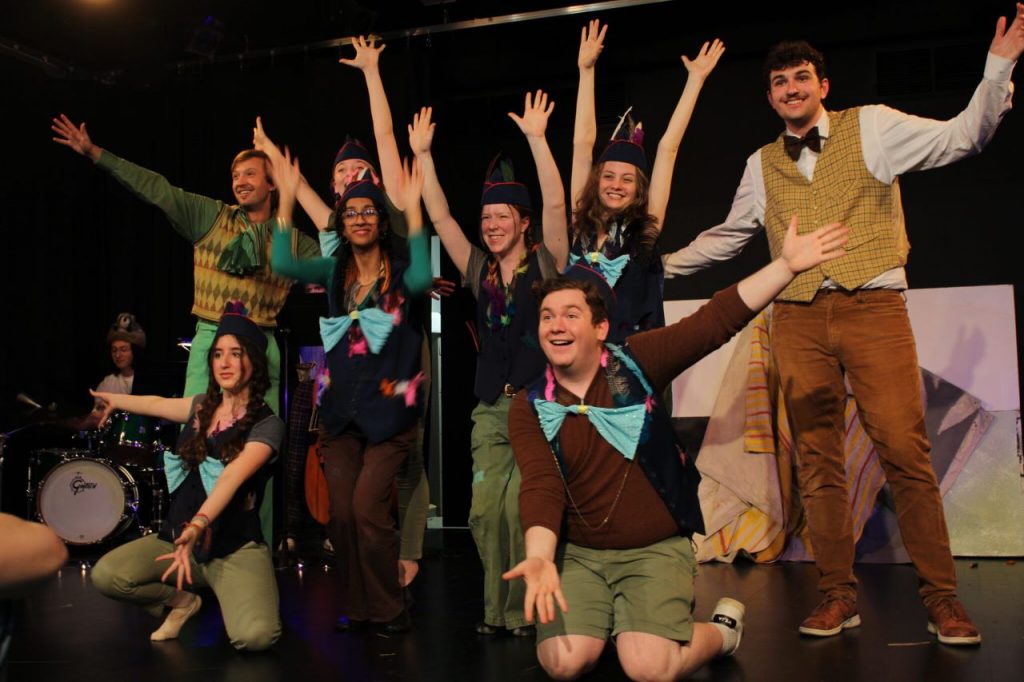BY ELLERY SHEA ’25

The Skidmore Theater Studio Lab production of Robert and William Reale’s A Year With Frog And Toad, directed by Josh Lucey ’25 and stage managed by Noah Greenfield ’24, debuted in Studio A of the Janet Kinghorn Bernard Theater on Saturday, April 20th, 2024. A Year With Frog and Toad features a year-long series of playful, musically-delivered vignettes featuring the titular Frog (Jimmy Katzmann ’25) and Toad (Ben Van Der Hulst ’25) from author Arnold Lobel’s revered 1970s series of picture books. An undoubtedly ambitious creative project, this production brought not only musical theater to Skidmore for the first time in many seasons but also children’s theater. From the first murmurs of its conception to the time of auditions, to early production, and throughout the rehearsal process, everyone involved was abuzz with excitement over this unique opportunity.
This excitement was as clear as day in the rehearsal room. Midway through their rehearsal process, I had the opportunity to visit the rehearsal room to get an inside look at their process. As soon as rehearsal began, Lucey gathered the actors for a short storytime to ground them in the source material of the play dramaturgically. That day, they were blocking the Shivers scene and started with the Shivers chapter where Lucey began reading about Frog’s encounter with a frog much larger than him. Just after he finished reading, Lucey extended his arms outwards and panned the book in the air to show his team the illustration inside. With one simple gesture, I felt a surge of nostalgia for being read a picture book that transported me back to my first-grade classroom in the best way possible. To me, this simple gesture reaffirmed that the production was absolutely in the right hands (pun absolutely intended). Next, I watched as Lucey seamlessly guided the performers through the scene, introducing them to the ever-growing array of puppets they would work with throughout the process.
Just a week later, I had the pleasure of attending the show’s Sunday matinee, and for the first time ever, I watched a predominantly young audience storm Studio A. Seating was available in the form of both chairs and mats. After entering Studio A, I took a seat on a blue mat with other audience members. Located centerstage and as close to downstage as possible, this was one of the best seats in the house! As I waited for the show to start, I flipped through the program and was delighted to find that it had been designed with its main audience in mind. I read so much fun information about the cast & production team and what everyone’s roles meant! The back of the playbill even had some fun activities, like a maze, a coloring page, and a “new words I learned” section. But before I could get started on these activities, the show began! In an instant, an ensemble of birds (Cat Scales ’27, Amara Rozario ’27, Alyssa Galen ’27, Ally Stanton ’27, Ben Harris ’27, and Naomi Wagner ’27) with bow-tie bird puppets flittered in to inform us (in a very chorus-line fashion) that “they had flown south for the winter!” Being on the floor and looking up at the performers in front made me feel like I was a kid again. Sitting on a mat enabled me to shift around slightly more than I would have been able to in a chair, making it an accommodating practice not only for young kids seeing the show but also for restless college students like me.

With the opening of a storybook backdrop onstage, we are introduced to the world of Frog and Toad: the months on a calendar are (literally) flipped through as Toad sleeps, and an actor’s hand appears from behind Toad’s nightstand to illustrate the rattle and shake of his alarm clock. It is through the characterizations of these onstage elements that simple objects are made vibrant. Eventually, Frog succeeds in waking Toad up, but no sooner does Toad end up intentionally breaking his alarm clock with a shoe. Throughout the rest of the play, Toad constantly references his inability to tell the time because his alarm clock is broken — just one of the show’s many charming gags
Much like the recurring alarm clock jokes, we get recurring appearances from the Snail With The Mail (Ben Harris ‘27). When Frog observes that Toad is upset over never having received a letter, Frog decides to send Toad a letter in the mail, via his good friend the Snail. While Frog understands this should take some time, he does not realize it will take as long as it does. Various scenes throughout the play are underscored by these brief interstitials of the snail trying to deliver Toad’s mail. Though it takes a while for it to arrive, the letter comes at just the right time to save Frog and Toad’s friendship, and after the Snail successfully delivers it, he proudly sings that he’s “coming out of his shell!” Throughout these musical vignettes, the show’s pacing is anything but snail-like – character costumes, puppetry, scenic, and character movement rotated with fluidity to make each season and number feel distinct.
But make no mistake, Lucey did not arrive at directing this tour de force without immense preparation. Incorporating musical direction, a live band, several ingeniously designed puppets, and coming in at around a 90-minute runtime (labs are typically capped at 70 minutes), Lucey’s rendition of A Year With Frog and Toad pushes the limits of what a Studio Lab can be (literally). As a reminder, the lab program exists to give student artists an opportunity to develop directing and other theater production skills in the form of a short rehearsal process — one which seldom involves any sort of musical direction due to its short timeframe. However, with the assistance of several musical collaborators, including Musical Director Johnny Mulcahy ’24 and a full live band who call themselves “The Amffibianz”, the accompaniment needed to make the show the spectacle it’s supposed to be became possible. Made up of Coltrane Cho ’24, (percussion), Fiona Burroughs ‘25 (bass), Francis Davies ’25 (banjo), Nate Lucas ’23 (piano), and Penn Hoen ‘24 (synth), the Amffibianz (a clever wordplay on the vertebrate family frogs and toads belong to, and musical notation) effortlessly navigate the variably showy, jazzy, and ‘30s-style score. Many young audience members were equally excited about the musicians as performers as they were with the actors, and with a performance so lively, how could they not?

Though the actors only had select opportunities within the three-week rehearsal period to practice with the live band, the latter had been rehearsing since February. Indeed, while the rehearsals for the actors took place within just three weeks, other collaborators had been toiling at this project for much longer. With eight actors, six band members, and thirteen additional contributors on the production team, A Year With Frog and Toad is undoubtedly one of the largest studio labs to date.
The passage of time in this play is no doubt aided by the charming scenic design, a collaboration between stage manager Greenfield and Lucey. Bringing up the back of the set is a large book that “flips” between various scenes and serves as a projection surface, used to make various onstage elements possible, such as the wind in “Down the Hill” when Toad is sledding, and the character of the Large and Terrible Frog who emerges during a scary story Frog tells the audience. In the latter, puppetry plays an even bigger role in bringing the Large and Terrible Frog to life: with assistance in construction from many (Asher Cortes ‘27, Becca Durst ‘27, Meghan Wax ‘27, and Logan Waugh ’26) Lucey succeeded in creating several puppets. For the Large and Terrible Frog, two actors donned a large hand on each side of the book, with Frog himself holding the head of his greatest nightmare. Several smaller creatures, including moles, squirrels, and birds were also brought to life through the medium of puppetry. Rounding off the overall visual tone of the play was Max McGuire ‘24’s costume design, masterfully selected from stock, with props such as the snail’s shell (crafted by Logan Waugh ’26) adding specificity to these creatures’ otherwise human costumes.
In addition to Stage Managing, Greenfield took on other important creative roles, including co-Props Coordinator, Carpenter, Painter, Projections Assistant, and Sound Assistant. But for Greenfield, participating in this production of A Year With Frog and Toad was no leap of faith. Greenfield had known he wanted to be a part of the project since Lucey first pitched the idea way back in Fall 2022, during a long day of Q-In for that semester’s Black Box production. Noah thought that the show’s music was very cute, and the idea of doing children’s theater sounded like an educational and rigorous challenge. Noah also shared the enthusiasm they sensed surrounding the project from their first impression, telling me that “Emma [Mangol ’24 (Lighting Designer)] and Josh both seemed so excited and I really wanted to work on a show with my friends, and we did end up putting together a massive production team full of very kind and talented people who were amazing to work with!”
I remember the first time I heard of Lucey’s production pitch for A Year With Frog and Toad last Fall. I was excited by the prospect of a grand undertaking for such a short process, one which would produce so many opportunities for students to take on roles not always offered. An intensively collaborative endeavor, the production engaged a wide assortment of students from all class years to bring the show to life, often engaging in production roles we do not get to see as much in studio lab processes.

Amongst these rarer types of collaborators, was the production’s main choreographer Lucrezia Zichichi ’24 (with assistance from Isadora Zucker ’25). The show included some particularly spectacular musical numbers, such as the “Intro” and “Getta Loada Toad.” In a conversation that I had with them leading up to the show, Lucrezia expressed how important the physicality was to these characters who were to be understood as animals by younger audiences, so they choreographed with that in mind. In the introductory number, which features the chorus of birds, Zichichi utilized “lots of little movements that birds typically do like the head tilts” to support the idea that birds “flock together,” while also having moments for each person to “put their specific flair on whatever they’re doing.” Later, in the comedic “Getta Loada Toad,” Zichichi utilized more literal choreography since there are a lot of words in the song and they didn’t want any of it to get lost on young audiences. That said, Zichichi’s process, like all of the other collaborators, was mindful of the production’s ethos.
In sum, from start to finish, A Year With Frog And Toad was a memorable production that generated several unique opportunities for its all-student creative team, cast, and band. As I left the performance, I wished to myself that I could spend another year with Frog and Toad to soak up just a little more of all the enthusiasm and inspiration that continues to radiate from its cast and creative team.
Photos by Logan Waugh ’26
***
Ellery Shea ’25 is a staff writer for the Skidmore Theater Living Newsletter
